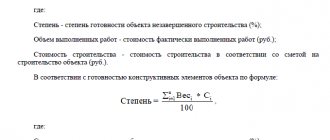Federal Law No. 214-FZ explains in detail how to sell real estate in houses under construction. It protects equity holders—buyers of housing under construction—from fraudsters and guarantees a refund if the developer fails to fulfill its obligations. In the law, the government stipulated what requirements developers must meet, as well as how they must conduct such transactions.
214-FZ is used if during the construction stage the developer plans to sell:
- apartments in an apartment building,
- townhouse, which consists of at least three blocks.
The law does not apply to individual construction, for example, private houses.
Who is the developer?
We often hear about developers in connection with the shared construction of new houses.
Advertising companies claim that buying an apartment from developers is more profitable. However, buyers often have a question: who are these developers?
The meaning of this concept is revealed by the Law “On participation in the construction of apartment buildings and other real estate objects” No. 214-FZ of December 30, 2004. A developer is an organization that:
- has experience in the construction of multi-apartment or other real estate properties;
- owns the land on which the building is being built;
- attracts funds for the construction of these facilities.
This term is also found in the Town Planning Code of the Russian Federation (Article 2). According to it, a developer is understood not only as an organization, but also as an individual who constructs objects, reconstructs them, and overhauls them on a plot of land he owns. In addition, they can carry out survey and other preparatory works for construction.
Developers actually organize all the work on the construction of houses or other objects. They must obtain a land plot, permits, and funds for this. However, they are not required to build it themselves.
Often, developers involve contractors in construction work. In this case, they also act as customers of the work. Since such people attract other people's funds, they are also investors.
Developer functions
The list of developer functions includes the following:
- Search for an investment option. The developer evaluates the real estate market and looks for opportunities to complete a transaction with the required level of profit.
- Analysis of the location of the future object. An assessment is carried out in terms of commercial attractiveness for potential clients. All offers of land plots in the desired area are examined. A decision is made to purchase a specific plot or object for reconstruction.
- Design of the facility, drawing up cost estimates. To construct or reconstruct a building, you must obtain appropriate permits. The project must be completed by a specialized organization (or employees of a development company with the necessary qualifications). Based on the project, a detailed estimate is drawn up. Inaccuracies in cost planning can lead to delays in construction.
- Attracting investors. To convince strangers to invest money in a development project, you need to competently present it and prove the economic efficiency of the investment. It is also important to clearly outline the likely risks and how to avoid them.
- Wise use of invested funds. The money raised should be enough for all the work. The developer is required to avoid unplanned losses.
- Supervision of the construction/reconstruction process. Control of the purchase and consumption of materials, monitoring compliance with technology. Personnel Management. If necessary, interaction with regulatory government agencies.
- Getting the maximum possible profit from selling or renting. Correct assessment of the market and choice of marketing strategy. Selection of clients and execution of real estate purchase, sale or rental transactions.
- Property management. Often, a development company also acts as a service organization for its facilities; for this purpose, a special division is created within the company’s structure to deal with routine repairs and provision of facilities with utilities.
Who is the customer
Who is the customer? The concept of “customer” is used in legislation primarily in connection with contract work. The parties to contract agreements are the customers and contractors. The former entrust the performance of any work to other persons and organizations.
Customers assign work, check the progress of its implementation, and then accept and pay for the result. It turns out that in any case, they do not carry out any work on their own, but only organize the process of their implementation. At the same time, they bear some responsibility for the outcome of the work performed by the contractor.
Interestingly, according to contract agreements, customers must create all the required conditions for the performers to work. One of the conditions is the provision of territory for development. However, the concept of the customer does not include ownership of the land transferred to the contractor.
According to the Law “On Investment Activities in the Russian Federation” No. 39-FZ (hereinafter referred to as Law No. 39-FZ), the customer is the person who has been entrusted by investors to implement a project. In other words, they must organize the construction of a real estate facility using allocated funds. Customers and investors can be one and the same person.
The largest developers in Russia
In terms of current construction volumes as of July 1, 2021, the TOP-5 development companies in the Russian Federation, according to the Unified Register of Developers, look like this:
- PIK Group, Moscow (7.4 million sq.m of real estate under construction);
- LSR Group, St. Petersburg (4.1 million sq.m.)
- Setl Group Holding, St. Petersburg (3.4 million sq.m.)
- CDS Group, St. Petersburg (1.5 million sq. m)
- YugStroyInvest Group, Stavropol Territory (1.36 million sq.m.)
However, construction volumes are not the only indicator of leadership. There are parameters for the number of facilities, the number of regions where these facilities are being built, the expected commissioning period, and so on. Based on the totality of all parameters, the CDS group and YugStroyInvest fall out of the top five, and the Stavropol developer generally falls closer to the bottom of the ranking of the Unified Register of Developers due to increased investment risks (almost half of the houses under construction have had their commissioning date postponed). At the same time, Moscow's Samolet-Development and Granel Group of Companies, with not the largest volumes of construction, are catching up with the leaders due to the better balance of their business.
Who is an investor
Investors allocate funds for specific purposes
This concept is disclosed by the provisions of the above Law No. 39-FZ. Investors can be any person, regardless of their status. They are organizations, citizens and even foreign entities.
Their main activity is making investments for the implementation of any projects.
In the construction industry, funds are invested for the construction of various buildings. Both own and borrowed funds can be invested. It is possible to combine these two investment options.
At the same time, investors allocate funds for specific purposes and have the right to check their correct expenditure.
An investment is an investment that is expected to bring profit to the investor later. They can be short-term or long-term in nature.
How to choose a developer
It is impossible to insure yourself one hundred percent against troubles with a developer. But there are several criteria, taking into account which significantly reduces the risk for an investor of being left without money and without real estate.
By length of time on the market and number of objects
The longer a company is on the market, the more likely it is that it will continue to be there. Such a company has a history of its activities, and you can see how often there are delays in the delivery of objects, what is the number of objects built, whether there have been long interruptions in work, etc. The geography of construction also matters. If construction has been going on for a long time in several regions, it means that the management of the development company is capable of conducting business on a grand scale and has reliable investors.
According to the list of investors and partners
The best option is if a well-known bank is in the same group with the developer, or large credit organizations are among the investors. This gives room for maneuver to the development company itself, as well as advantages for the client, who has additional opportunities for preferential lending for the purchase of real estate on site. In addition, it is good if the developer’s partners include well-known construction companies; there is no point in ruining their reputation by joint projects with an unscrupulous company.
Based on the availability of project declarations
There is no point (or opportunity) for fly-by-night companies to post project documentation for past projects. Real developers comply with the law, which obliges them to post construction documentation for the last 3 years on the developer’s official website. In addition to purely construction issues, open declarations also contain information about the developer’s debt.
Who is a contractor
Is the developer the client or the contractor? A contractor is a person who is directly involved in the execution of work. They carry out their activities on the basis of instructions from other persons. Their role can be customers or developers.
It is the responsibility of the customers to provide all conditions for contractors to carry out the work. The performers (contractors) must act in accordance with the assignment and provide the result of the work within the deadlines established by the contract. Construction must be carried out strictly within the framework of approved projects, building rules and regulations.
Developers whose business failed
According to the rating agency of the construction industry (RASK), in 2018 in Russia there were almost 150 development companies with a total area of 4.5 million sq.m. in various stages of bankruptcy. In total, more than 40 thousand people have suffered from bankruptcies of such companies over the past 10 years in the Russian Federation. Here is a list of the largest collapsed developers in recent years:
- Group "SU-155" (owner Mikhail Balakin). For several years in a row, she headed the TOP 5 largest developers in the Russian Federation. The group at the time of bankruptcy (2016) included more than 100 enterprises. Almost 150 objects remained unfinished.
- Mirax Group (owner Sergey Polonsky). In 2010, it was one of the five largest developers in the Russian Federation. But the economic crisis that began in 2009 undermined the position of the company, which at that time employed more than 4 thousand people. In 2011, the brand ceased to exist, the owner closed some of the business structures, and restructured some due to growing debts to banks. As a result, over 600 thousand square meters of real estate were not delivered on time.
- LLC "Transfort" (owner Yuri Kuznetsov). This company was created specifically for the construction and management of a grandiose housing complex of 45 apartment buildings. The investors were legal entities and individual shareholders, and the co-investor was Military Construction Bank. A year after the start of construction, it was stopped, 8 buildings remained in varying degrees of completion, and they did not even have time to connect communications. More than one and a half thousand people suffered from the developer’s bankruptcy.
- Management Company "Premier Development" (owner Alexey Muromtsev). About 1,000 shareholders who invested money in the Swan Lake housing complex in the Moscow region were left with nothing. There were clear signs of fraud in the developer's bankruptcy.
- GC "Skyscraper GB" (owner Babek Hasanov). The Novo-Nikolskoye residential complex in New Moscow deprived about 800 investors of their funds. The reason was a conflict between the co-founders.
Who is the developer and who is the customer - their relationship with each other
Despite the similarity of these concepts, they still have significant differences. The easiest way is to distinguish them from other contractors, since they are the performers of construction work. They carry out them according to the instructions of the customer (developer) when creating the conditions required for the construction of objects.
Developers have more extensive functions than other ones. They can act as customers, investors and even contractors.
The customer is not always a developer and investor, and does not perform the functions of contractors. Investors are engaged in investing funds in different projects. Customers and developers can act in their role.
Guide to the world of construction
The relationship between construction subjects is difficult to understand, so if this is your first experience in the primary market, we recommend using the help of specialists.
Call center Yuga-build.ru will help both beginners and professionals. What is the difference between a developer and a contractor, who is the customer, where to get a mortgage, is it possible not to pay a down payment, which construction company is the most reliable - you will find answers to these and other questions with us. The site has an easy-to-understand interface, all information is comprehensively arranged, and a convenient search based on specified parameters is configured. All the most important and interesting things are on the first lines. With all this, we are a purely information portal; data on modern developers from different regions is collected here. The site's services are absolutely free, we are not an intermediary. Here you can watch, search, study. The customer support hotline will help you quickly contact the construction company you are interested in.
conclusions
At first glance, it may seem that the concepts of customers and developers are identical. But in fact, each of them has its own distinctive features.
To properly understand the functions of these construction subjects, it is important to understand their meaning.
Standard contracts in construction:
See also Telephone numbers for consultation May 03, 2021 Yulia Yurievna 961
Share this post
Discussion: there is 1 comment
- Marina says:
20.11.2020 at 12:22That is, the developer is not a specific single person, but a certain circle of people or an entire company that is engaged in development? Or can the developer also be one person?
Answer
Notes[ | ]
- The concepts of “development”, “developer”, “project” and “project management” (undefined)
(inaccessible link). Retrieved November 17, 2010. Archived October 12, 2010. - ↑ 12
S. Maksimov. Development (real estate development) - organization, management, financing. - V. Spitsyn. Who is a “Developer”?
- Stages of development. (unspecified)
(inaccessible link). Retrieved July 11, 2015. Archived July 12, 2015. - Types of development Archived copy dated May 16, 2010 on the Wayback Machine
- Focus on profit, or Why developers are needed
General contractor - who is it?
General contractor, general contractor - a person who performs work in accordance with a contract by involving other persons. The general contractor is responsible to the customer for the implementation of the entire range of works established by the contract.
To be more specific, in the field of housing construction, the general contractor is considered to be a construction company that has entered into an agreement with the developer/customer. It is this organization that undertakes to carry out all construction and installation work on the construction site on time.
The general contractor can involve several additional contractors for each type of work (installation of an elevator, glazing, etc.) or choose one subcontractor to whom he will entrust the project completely; we will tell you more about subcontractors later.
In some cases, the following chain is possible:
Developer - General Contractor - Contractor - Subcontractor.
In this case, the general contractor's job will be to supervise the work of both contractors and subcontractors. If the Contractor and Subcontractor work on the construction site simultaneously with the General Contractor and simply perform different functions, then they can all report to the Developer together. This use of additional construction companies may occur due to the lack of necessary equipment or personnel, tight deadlines, and other similar reasons. The general contractor must have a license that allows construction work.
The main feature of a general contractor is that he only builds. Its representatives will not be able to answer the investor’s questions about what is included in the price of the apartment or how quickly the property is sold. In addition, the functions of the general contractor most often do not include services for developing estimates and architectural design. These works are either carried out by the developer themselves, or they are ordered from a special architectural company.
But in some cases, the general contractor acts as the designer of the facility and the organization that carries out all construction work. Then the customer can sign an agreement with the general contractor for architectural or technical supervision. This will provide for control by a specialist architect over how well the construction team is working, whether the construction and installation work corresponds to the project, etc.
The rights and obligations of technical supervision are regulated in accordance with Resolution No. 903.
Technical Supervision
Regarding the issue of technical supervision, if it is not carried out by the general contractor (which should be indicated in the documents), then responsibility for it lies with the developer. The latter can provide technical supervision in the following ways:
- independently, if the organization has qualified employees who have a certificate issued in accordance with the law by the architectural and construction certification commission;
- involving third parties (having the necessary license).
Thus, the developer is the main person with whom investors/buyers contact in the absence of a management company. And it is the developer who is responsible to investors for everything that happens in accordance with the agreement they signed.
What does a development company do?
Development services are provided by companies implementing real estate projects, and in construction, a project is called the reconstruction or construction of an object. Companies are engaged in a full cycle of work, from analysis of the idea to delivery of the object to the customer in finished form. Companies can do more than just construction and restoration. Sometimes renovations are done to increase the cost. This type of work is called renovation. All the nuances of cooperation are stipulated in the agreement concluded by both parties. It indicates the timing, cost, and list of works. Depending on the complexity of the project, the price for the company’s services can reach 10% of the cost of the object. In fact, the concept of development in construction implies management, management of the facility. This is considered to be one of the most profitable types of business in the world. In Russia it is developing rapidly and is one of the most promising.
Distribution of roles, according to regulatory documents
The question of determining the difference between the functions of various subjects in construction comes down not only to creating the most effective model of work on the project. (Although standardized experience and established interaction patterns simplify the activities of participants and help avoid many mistakes). Resolving the issue of determining the boundaries of rights and responsibilities is important when conducting business disputes. And since the judicial authorities making decisions will be guided in their choice by the provisions of regulatory documents, one should turn to the primary sources.







